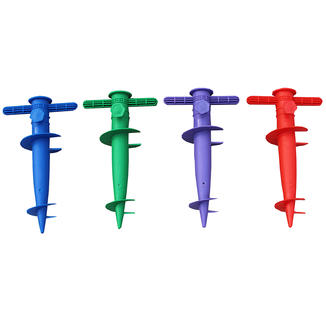In rainy climates, the durability of patio umbrellas depends directly on whether the material can resist moisture, mold and frequent temperature changes. Improper selection may cause the ribs to rust, the fabric to fade or the structure to deform.
Umbrella: The synergy of mildew-proof coating and high-density fiber
Although polyester is light, it is easy to breed mold when exposed to rain for a long time, and the seams are prone to water seepage. For rainy environments, Solution-Dyed acrylic fiber is the first choice - its dyed yarn is dyed when the fiber is extruded, which is 3 times more UV resistant than the post-dyeing process, and the surface is treated with Teflon® waterproofing, with a water contact angle of 115°, which can quickly roll off rainwater. For example, actual data from the Florida coast shows that after 5 years of use in areas with an average annual rainfall of 1500mm, the tear strength of this type of fabric only decreases by 12%, far exceeding the industry standard.
Umbrella ribs: The dual protection of corrosion-resistant metal and structural design
Although the aluminum frame is light, it is prone to electrochemical corrosion in salt spray and humid environments. It is recommended to choose powder-coated galvanized steel: the zinc layer provides sacrificial protection, and the outer epoxy powder coating can resist acid rain erosion with pH 3-11. A better option is aviation-grade aluminum alloy (such as 6061-T6), whose magnesium-silicon alloy composition is combined with anodizing process, and has a salt spray resistance test of more than 1000 hours without rust. It is worth noting that the 304 stainless steel hinges at the connection of the ribs can prevent the nodes from rusting and ensure the smooth opening and closing for ten years.
Umbrella handle and base: the art of drainage design and weight balance
Wooden umbrella handles are prone to expansion and cracking in humid environments, while hollow plastic tubes are prone to water accumulation and breeding bacteria. Solid teak has self-corrosion properties due to its high natural silicon content (>0.5%), or a hollow umbrella handle made of HDPE (high-density polyethylene) injection molding can be selected, and the internal diversion groove design can quickly drain rainwater to the ground. It is recommended to choose a base filled with concrete or cast iron, and the weight must be more than 1.5 times the total weight of the umbrella to withstand level 8 gusts.
Use a soft-bristled brush to clean organic residues (such as leaves and pollen) from the gaps in the umbrella every month to prevent acidic substances from corroding the coating;
After the rainy season, wipe the metal parts with a vinegar-water solution (1:10 ratio) to neutralize the salt;
When storing in winter, keep the umbrella half-open to avoid condensation water accumulation in a sealed environment.

 English
English España
España EN
EN ES
ES











